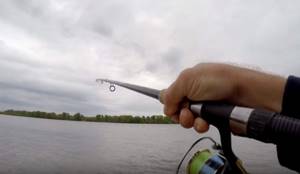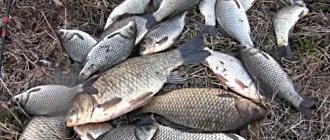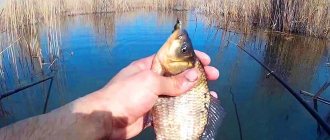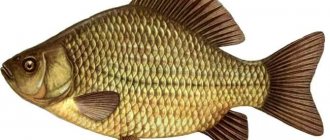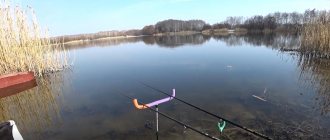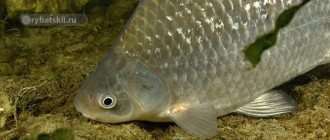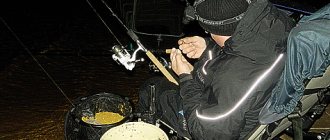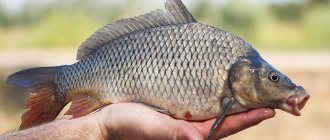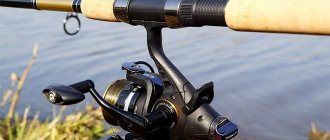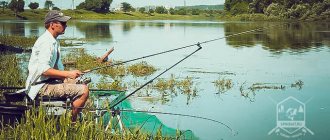Crucian carp is an unpredictable fish. Usually everyone is used to catching crucian carp with a float rod not far from the shore. But in this case you can catch small fish. Catching crucian carp on a feeder is more effective.
The feeder allows you to catch larger crucian carp, which stays away from the shore in the depths. The efficiency of using feeder gear is increased through the use of a feeder. You can throw not only equipment, but also bait over a long distance.
The use of feeder equipment is invisible to cautious fish; there is no fishing line rising up near the nozzle. From one point you can fish a larger area than with float gear.
Fishing gear
Feeder tackle is a rod with rings on which a reel with fishing line is attached. The tip of the feeder is movable, it informs the fisherman about the bite. The equipment uses a feeder.
If you want to learn more about how to make feeder tackle, you can read our article.
Rod
The choice of rod depends mainly on the expected casting distance. The feeder length can be from 3 to 3.6 meters. The further the expected distance, the longer the feeder should be. A rod up to 4 meters long is unjustified.
Casting at a distance of up to 100 meters and no longer will be needed to catch crucian carp. According to the dough, you can use ultra light, light and medium tops, with dough from 30 to 80 grams. The use of large loads is not justified. Crucian carp, unlike carp, can quickly get enough and lose interest in the bait. According to the action, it is recommended to use soft or medium rods.
Coil
There are no special requirements for the feeder reel for crucian carp. This can be any reel with a front or rear friction brake. With a spool size of up to 3000. Large sizes are unjustified, the crucian carp is not strong enough to reel in even a few meters, and the available size is enough to restrain a small carp.
Using large, heavy reels will only unbalance and make the tackle heavier.
fishing line
Since the feeder tackle is quite complex, it uses two types of fishing lines. Main line and leash line. As the main line, you can use either a braided cord with a diameter of 0.14 - 0.16 mm or a monofilament line with a diameter of 0.2 - 0.25 mm.
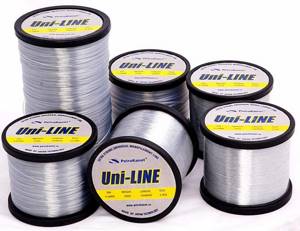
There are no special preferences for using the line option. Braided cord does not have the same need for its use as in spinning gear, where constant control of the bait is necessary.
Feeder gear involves freely placing a leash on the bottom so that the crucian carp can calmly take, taste the bait and swallow it without immediately spitting it out. This means that constant monitoring of the bait is not necessary. Monofilament thread can easily handle the tasks of the main line. In addition, it is an order of magnitude cheaper than braided cord.
Leash
For the leash, it is quite possible to use monofilament fishing line with a diameter smaller than the main fishing line. Typically, leashes of 0.1 - 0.14 mm are used.
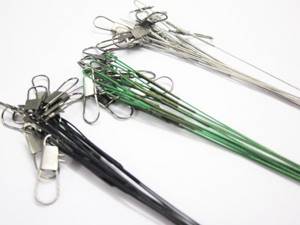
When catching cautious fish, even thinner lines are used . Fluocarbon can also be used, but it must be taken into account that, despite its invisibility, it is a more rigid material than monofilament. If the bite is weak, you always need to experiment not only with baits, but also with materials and leash length.
Feeder
The choice of feeder weight and rod test are directly related. The greater the mass of the feeder, the larger the test should be. Conversely, the larger the tip test, the heavier the feeder can be used. Depending on the shape, you can use different types of feeders.
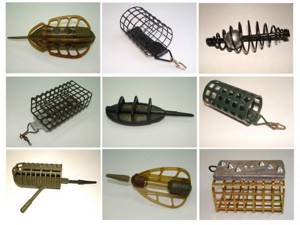
If there are a lot of snags and stones at the bottom on which the feeder can get caught, then it is better not to use feeders in the form of cages, but to use special streamlined feeders. In spring, crucian carp come to the shore, where the water warms up faster; the shape of the feeders does not matter.
In summer, crucian carp move away from the shore, so cone-shaped feeders are used for long-distance casting.
Spring tackle for crucian carp
Rod
A medium-class feeder blank with a test weight of up to 90 g, a medium or fast action, and having a length of 3.6-3.9 m will be universal. With this rod you can fish both at short distances and cast to the opposite bank of the reservoir.
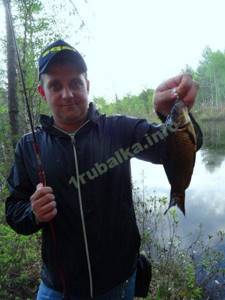
When your fishing distance does not exceed 20-25 m, a picker rod with a weight of up to 40 grams would be an excellent option; the feeder is light and makes an order of magnitude less noise when casting. The length of such rods does not exceed 3 meters, which is very convenient when you fish on a bank overgrown with dense vegetation or under the canopy of trees.
Coil
To catch crucian carp on a feeder in the spring, a small inertia-free reel with a spool size of 2500-3000 is sufficient, the main thing is that it is balanced with the rod. Do not forget about the presence of a good clutch, since in the spring in shallow water you can find not only crucian carp, but also more respectable fish.
fishing line
Monofilament with a diameter of 0.2-0.24 mm or braided 0.12-0.15 mm, braided fishing line works especially well in early spring, when the fish are inactive and take the bait very carefully. Leaders are 0.03 mm thinner than the main line or designed for a lower breaking load.
When equipping a reel with braided fishing line, do not forget that the spool must be metal or coated, and the guide rings must be equipped with special inserts.
When fishing in shallow water during strong winds, your line may begin to blow out of the quivertip, making it impossible for you to track bites. You can solve this problem by using a shock leader made of fluorocab in two rod lengths; it will sink your line well.
Feeders
On moderately silted bottoms, regular cage feeders can be used. On reservoirs with a large layer of silt, fishing for crucian carp on a feeder in the spring is preferable to plastic feeders with plastic wings on the sides and flat-method feeders.

Hooks
Sharp, but not too thin, since crucian carp have delicate lips, size No. 16-18 according to the international classification.
Feeder equipment
There are quite a lot of options for equipment for feeder fishing, more than 15 installations. The specific installation is used depending on the fishing conditions. The easiest to use and satisfying most fishing conditions is the Paternoster installation. It is convenient and easy for beginners to learn and use.
Manufacturing:
Two loops are knitted on the main line. One is small, at the end of the fishing line. A leash with a hook is attached to it. The second is large, its size should allow the feeder to pass through it. It is knitted at a distance of 30 cm from the place where the leash is attached. The feeder is attached to the large loop via a swivel or clasp.
How to assemble feeder equipment for crucian carp
The crucian carp feeder is similar to the technique and principles of carp fishing, because the bulk of the elements of the fishing method are borrowed from this direction. The angler uses various types of equipment based on the activity of the fish at the time of the fishing session, thereby making the equipment more sensitive when biting passively and faster when the fish are hungry and highly active. Let's consider the most commonly used types of feeder installations, superimposing them on the characteristics of crucian carp habits.
Primitive equipment
The peculiarity of this installation is the use of equipment without a feeder. The fishing spot is fed manually, from a slingshot, or by simply throwing balls into the fishing zone. A sliding weight is mounted on the main cord, the movement of which is limited by stoppers, a leash with a hook and bait. Installation is used during active biting.
Equipment with anti-twist
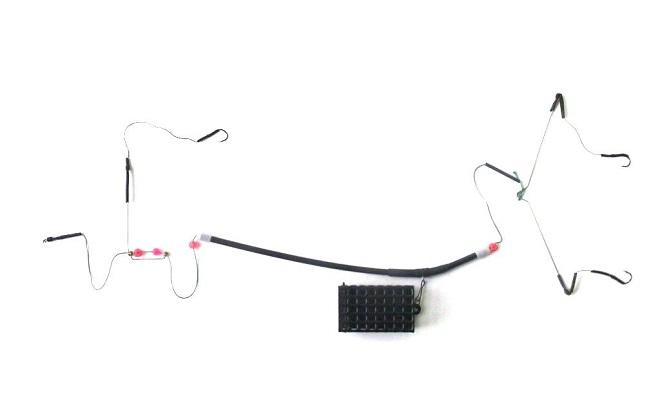
The installation includes a plastic rocker with arms of different sizes, which prevents the leash and the main cord from tangling during casting. The type of feeders is in the form of a spring, sliding along the main cord. This set of equipment is recommended for beginner feeders, but is also successfully used by experienced anglers when catching cautious fish using long leashes. Suitable for passive biting conditions.
Paternoster type equipment
Installing the feeder on a rigid line branch from the main cord allows you to use a variety of feeder options of various designs. It is used by crucian fish on hard bottom grounds and is considered a rough rig that is successfully used during active biting. When the fish bites, it hooks itself. The paternoster, due to its simplicity of tying and low quality of entangling elements, allows you to fish at a very fast pace.
Asymmetrical loop
More complex installation, greatly increasing the sensitivity of the gear. Used in conjunction with a rectangular mesh feeder for crucian carp. Anglers use this type of equipment when there is low fish activity and uncertain bites, reacting with an immediate hook to every tiny signal from the guard.
Symmetrical loop
Knitting a symmetrical loop refers to a universal feeder installation. Without knowing the reservoir and the habits of local fish, it is recommended to start fishing with this type. All types of sliding feeders are applicable in the equipment, and you can fish on both muddy and hard bottom grounds. Even sluggish late autumn crucian carp on a feeder can be successfully caught with this version of equipment, self-hatching at the slightest bait samples.
crucian carp killer
A type of equipment that includes a garland of a couple of three feeders in the form of springs, rigidly, in series one after another, mounted on the main cord. Each feeder is individually crocheted with a short, up to 15 cm, leash, equipped with a miniature crochet hook with virtually no shank. The hooks are pressed into the bait, which is tightly driven into the springs. The fish, sucking out the food, absorbs the hooks along with the mixture, self-cutting with the equipment. In this type of fishing, feeding crucian carp with a well-chosen complementary food composition is a decisive factor in the success of fishing.
Installation
Installation of gear begins with the assembly of the feeder rod. We place the tip depending on the fishing conditions (weight of the load). Next we place the reel with the main line. We pass the fishing line through the rings.
At the end of the main line we make a loop to which the equipment will be attached directly. The equipment can be made directly on the main fishing line, but for convenience it is better to knit various equipment at home. When fishing, one equipment can be replaced with another without cutting off and throwing away the first installation.
Where to look for crucian carp in spring
Fishing for crucian carp in the spring will bring good results only if the feeder knows the potential fish sites at this time of year.
Early spring
The crucian carp bite usually begins 10–20 days after the final melting of the ice (depending on the prevailing weather conditions), when the water temperature approaches 13 degrees. During this period, in stagnant bodies of water they look for it in coastal waters, where the depth is no more than one and a half meters. The main fishing sites on the river are:
- shallow bays;
- oxbows;
- flooded meadows.
At the beginning of spring, it makes no sense to come to the reservoir too early. The crucian bite usually starts at 8–9 am. Fish exhibit increased feeding activity in clear, calm weather. In rainy weather, crucian carp go deeper and stop responding to any type of bait.
Late spring
In late spring, crucian carp are distributed evenly throughout the water area. In the second half of May, it is caught not only in shallow areas of the coastal zone, but also at a considerable distance from the coast, where depths are from 2 to 3 meters.
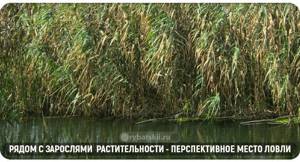
When choosing a fishing location, give preference to areas located next to thickets of aquatic vegetation. Here the fish finds food and hides from predators.
River carp still spend most of their time in bays and oxbow lakes, but they go to areas with the current to feed. If in shallow places the bait is often taken by individuals weighing 100–300 grams, then closer to the main channel bites of specimens weighing more than 1 kg occur. The exception is the night hours, when even large crucian carp come closer to the shore.
If at the end of April and beginning of May crucian carp showed increased feeding activity during the daytime, then towards the end of the season it bites better in the early morning and evening. The largest individuals are caught on amateur gear at night. Warm, cloudy weather is more suitable for fishing.
Choosing a fishing spot
To select a fishing spot, you need to find a section of the coast without bushes and trees in order to safely cast the gear. If the reservoir is unfamiliar, then you need to study the bottom using a marker float, or by counting the time when an empty feeder or a regular sinker falls. It is necessary to choose a place without a current.
Crucian carp loves calm water. We are looking for a fairly large area with a flat bottom, which is called a “table” in the fishing community. It is on a flat area that it is best to feed, luring crucian carp. If you have several feeder rods, then it is better to choose several different points both in depth and in distance from the shore.
Catching crucian carp in May with a float rod
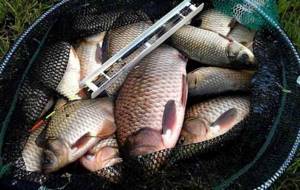
This month crucian carp is caught at some distance from the shore, so fishermen choose a long rod - from 4 to 6 meters. The rod should be as light as possible so that it is possible to cast the bait into the water quietly, because crucian carp are shy in the pre-spawning period, and excess noise will scare them away from the feeding area. If the fishing rod is equipped with a reel for long-distance casting of bait, then it is permissible to use a rod of shorter length. Read also: How to equip a float rod for catching crucian carp
Some information about what types of float rods there are:
- flywheel - there are no rings or reels on it, the fishing line is attached to the tip of the rod, the casting range corresponds approximately to the sum of the lengths of the blank and the fishing line;
- match - equipped with a large number of rings, there is a place to attach a reel, this rod is used by professionals and sports fishermen;
- Bolognese - the most popular fishing rod among amateur fishermen, equipped with a number of rings and a reel seat;
- plug-in - the rod consists of several parts that are connected to each other using connecting tubes; without certain skills, it is not easy to use.
This is interesting: Fishing for crucian carp with a sliding float
May crucian carp is shy, so the fishing rod is equipped with a thin fishing line - from 0.12 millimeters to 0.18 millimeters. Light floats weighing up to a gram are placed on the fly and plug fishing rods. Goose feather type floats have proven themselves well; they are very sensitive to the slightest bite.
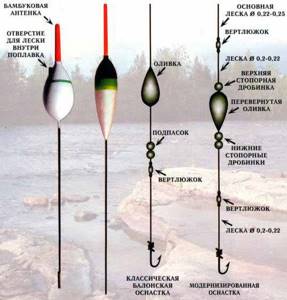
Match fishing rods are equipped with floats weighing approximately 12-15 grams; for a Bolognese fishing rod, a float weighing from 3 to 5 grams is sufficient. The floats are surrounded by lead weights in the form of pellets. Their weight depends on the buoyancy of the float: a gooseneck float requires a small shot, a float weighing 15 grams must have a heavier weight.
The process of equipping the fishing rod is completed with a hook - it is advisable to use a high-quality and very sharp product from well-known companies, No. 10-14 according to the international classification, or No. 3-5 according to the domestic numbering.
Lure
Bait is the most important component when fishing with a feeder. It is this that is capable of attracting cautious and large crucian carp to the bait. The bait can be of different composition. You can prepare it yourself or purchase it at the store.
Purchased mixtures
If you don’t want to get involved with making complementary foods yourself, you can purchase them at the store. There are a lot of complementary food manufacturers, but you need to choose a well-known seller.
The bait mixture must be fresh. It includes all the necessary components that attract and hold crucian carp at the feeding site. Using store-bought mixtures from well-known brands is quite expensive.
2. Making your own bait mixture
Complementary food for crucian carp can be made at home, and just mix it in a pond. As a rule, the composition of complementary foods is small. The following composition can be used:
- Twisted sunflower seeds in a meat grinder (combine) into 2 parts.
- Breadcrumbs 3 parts.
- Bran 1 part.
- Boiled millet 1 part.
- Hercules porridge 1 part.
- Corn flour 1 part.
- Flavors.
In fact, there is no ideal complementary feeding option for crucian carp. He is so picky that his preference can change in a matter of hours.
Combining mixtures
To save costs on bait, you can mix ready-made mixtures with the base for making your own bait, that is, breadcrumbs and cake. The flavorings in purchased complementary food will be enough to attract crucian carp to the fishing site.
You can combine complementary foods on a pond. To do this, you need to take several baits of different tastes, and a homemade base for diluting store-bought bait. In addition, this will save costs.
Baits
Crucian carp is so omnivorous that it can take both animal and plant baits. He buys worms, maggots, pearl barley, corn (steamed or canned), bread, dough, semolina.
What bait to use depending on the time of year. In spring, crucian carp prefers animal baits; it needs as much protein as possible after winter. In summer, he willingly takes vegetable baits (corn, pearl barley, dough, etc.). But this does not exclude the possibility that in summer crucian carp will not take bait on animals.
Mixing bait
A good bait must include both plant and animal components. Only thanks to this combination will the fish become interested in the smell and swim to the required place.
A finely ground mixture consisting of:
- breadcrumbs;
- rolled oats;
- cookies;
- sunflower seeds;
- bloodworm, worm or maggot.
Fish preferences may vary depending on the body of water, so you can try adding pea or corn meal. You can also use semolina. As a supplement, many experienced fishermen use vanilla or cinnamon flavors.
Mixing takes place on site. For an open feeder, it is worth choosing a water ratio that will make the bait viscous and will not allow it to crumble in flight. It will have to be gradually washed out from a container-type feeder. It is also permissible to use clay or sand from the coastal zone.
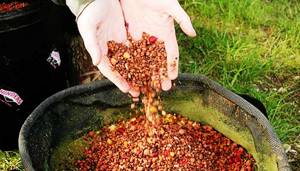
Adding this component will make the smell of the bait more natural and familiar to the fish; in addition, the fish will swarm around in the provided mixture for a long time, looking for nutritional components. She will remain in one place for a long time, while she will remain hungry and will soon stumble upon the hook.
Fishing technique
Catching crucian carp on a feeder has its own characteristics. After collecting the gear, you need to mix the complementary foods. If the place is not familiar, then we look for promising points. Unlike carp fishing, a promising place is not fed, or only slightly fed.
Crucian carp gets full very quickly. Therefore, the main hope is that he will be attracted to complementary foods in the feeder. You can feed with a feeder, making 3-5 casts with complementary food at one point.
After feeding, we put bait on the hook, fill the feeder and throw the equipment into the fishing spot. You need to mark the fishing spot, find a landmark on the other side, for example, and cast to a certain distance, making a mark on the fishing line. After casting, place the rod on a special stand and tighten the line.
At the moment of the bite, when the rod tip is indicated, you need to wait a little and then hook, but not sharply.
Crucian carp fishing at different times of the year
Despite the fact that fishing for crucian carp with a feeder at different times has much in common, there are also differences associated with the temperature of the water and the environment.
in spring
Catching crucian carp with a feeder in the spring involves the use of animal baits, since the fish needs protein after a long winter.
During the pre-spawning period, this fish will peck at a worm or bloodworm, and after the first insects appear, they are also used as bait.
Few people catch crucian carp using the larva of the Colorado potato beetle, although such bait is very tempting and catchy, and in different regions. The red larva attracts fish visually, and its taste characteristics are very popular, especially with trophy crucian carp.

Another option is the burdock larva, which is found in old shoots and dry plants.
The use of grain baits and dough in the spring does not justify itself and the crucian carp responds to them reluctantly.
Spring crucian carp fishing on a feeder gives a lot of unforgettable emotions, especially considering that it is too early to catch carp or grass carp, and small white fish are not of much interest.
In summer
In the warm months of the year, fishing for crucian carp with a feeder or picker is rich in solid trophies, especially if you choose the right place near reed thickets, or find undercuts; there is always a lot of fish at such points.
In summer, vegetable attachments work, as well as various types of dough, especially those mixed with semolina and fried cornmeal.
Worms and maggots will also interest fish, but less than in autumn or spring. Summer bait is made “dusty” in order to attract fish from distant horizons.
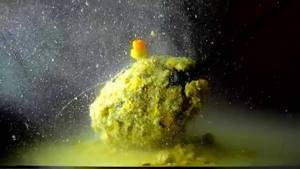
in autumn
Autumn crucian carp is especially voracious and responds with pleasure to most baits.
But still, take into account the specifics of its behavior and the desire to fatten up for the winter, that is, again, the fish needs protein, so plant baits will be less attractive.
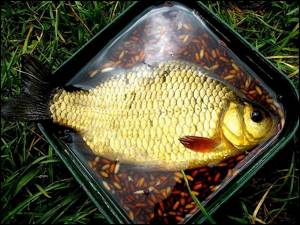
In the autumn months there is no need to use a large amount of bait; crucian carp actively moves in search of food and is sensitive to the slightest tempting odors.
It is important here not to overfeed the fish, so the bait in the feeder is served in small portions with pauses of 10–15 minutes if there is no bite.
The best time to catch crucian carp on a feeder
You can catch crucian carp after the ice has broken up. He approaches the shore, where the water warms up faster and he is more active after hibernation. A couple of weeks after the ice melts, crucian carp go to spawn. During this period of time, the crucian carp is hungry. After spawning, it takes more than a couple of weeks, after which it begins to feed. Crucian carp is active until autumn.
In some reservoirs it also feeds in winter. If the bottom of a reservoir is muddy, then it buries itself in the mud and goes into “hibernation.”
Recommending biting times for crucian carp is a thankless task. Its whim depends on many factors, weather, availability of food, wind, precipitation, etc. The prevailing beliefs about the best bite at dawn and dusk are confirmed, but you can also catch crucian carp successfully during the day.
Early spring
- Many fishermen are concerned about the question of when crucian carp begins to bite on the feeder in the spring. It all depends on the location of the reservoir and the local characteristics of the onset of spring. In the south, silverfish are caught from the ice in winter even in ponds, and in the north, in harsh winters, they usually spend time in suspended animation, buried in the silt and waiting out difficult times.
- On the other hand, in the spring, crucian carp are more active, since the oxygen regime is better in reservoirs with flow. In rivers and flowing reservoirs, crucian carp become active earlier in the spring.
- In southern reservoirs, still under the ice, it gathers in large flocks at the mouths of tributaries and near the shore near thickets, so that with warming in the spring and flooding, it moves to spawning grounds. In the south, the stage from ice melting to high water is short - sometimes rivers flood as early as early March.
- In more northern regions, the silver glutton becomes active after the ice has melted, leaving the depths as the water warms up and moving closer to the coastal shallows in the spring.

Therefore, the stages of catching crucian carp in early spring on a feeder should be divided not by months, but by the degree of natural changes:
- Ice melting, clean and cold water. The fish is not active yet; if bites occur, they are more by accident, when the hook with bait falls right under the fish’s nose.
- When the water warms up to 7-8 degrees in the spring (in the south - still under the ice) - the fish move to the shallows, gather in schools, and begin to feed.
- Flooding of rivers means a spawning season, an increase in the intensity of the bite, turning into a meal before, during and after spawning.
- Pre-spawning Eldorado, when the main thing is to find crucian carp, but it is caught by everything and everyone. Typically this period falls in mid-April - May.

Therefore, it is important to find out whether silverfish are being caught in a particular body of water at this time of spring. This can be done on fishing forums or ask local feeders. In addition, the timing of spring warming is different from year to year. As we have already said, crucian carp is a noble opportunist, so there are few axioms in its behavior. Somewhere it is caught in the spring in cold water, in other places - only with warming.
The probability of being caught in the river is much higher - here the silverfish are already actively gathering in schools in order to have time to move up the tributaries into the flood. In the ponds there is nowhere to go, and the crucian carp wakes up slowly, the bite increases smoothly, with the water warming to 10-12 degrees. In any case, until the bite intensifies, fishing takes place in winter mode - a thorough search, a minimum of bait, small animal bait on the hook and thin, neat feeder rigs. Article about fishing for crucian carp in April
The nuances of catching crucian carp on a feeder at night
Large crucian carp, like large carp, like to feed at night. The larger the fish, the more careful and timid it is. Since there is more food near the shore, where vegetation prevails, large crucian carp come closer. For night fishing, you need to find the first edge during daylight hours, measure the distance on the fishing line and, at dusk, cast the feeder at the nearest edge. At night, visibility deteriorates, and the flashlights used are not of any use, since crucian carp are afraid of everything, and even the strange light on the shore.
Therefore, it is better to use electronic signaling devices rather than tops as signaling devices. In this case, it is necessary to loosen the clutch and use a sliding installation. It is better to use several rods in night fishing, casting baits at different distances.
Fishing for crucian carp
For successful fishing, it is recommended to make several test casts of empty gear to the intended location. This will help to most accurately deliver the feeder to the planned area. After the tackle hits, a mark is made on the fishing line, which fixes its length for subsequent casts. Next, the area is fed. After half an hour, you can start fishing for crucian carp.
Having detected a bite, the fish needs to be hooked. When fishing, crucian carp can show aggression, and in order to prevent it from breaking, it is also recommended to show aggression by pulling and reeling in the fishing line. Crucian carp fights for its life to the last, so when you see it on the surface, you shouldn’t relax. To avoid missing fish at the last moment, it is recommended to use a landing net.
Crucian carp is an unpredictable fish that requires constant experimentation, however, one rule always applies.
By positioning the tip of the feeder rod as close to the surface of the water as possible, the angler is more likely to spot a clean bite. In this case, it is better to hook the fish to the side with a very smooth movement. By following this rule, you can feel a significant reduction in water resistance. Article on the topic: Fishing for crucian carp in spring
Tips for catching crucian carp on a feeder in spring, summer, autumn
In spring, you can start catching crucian carp from April. You need to look for shallow areas of the reservoir. The crucian carp goes to shallow water to bask. There are frequent bites near the shore, a few meters from the water's edge. It is better to put bloodworms, worms, and maggots on the hook. You can use a sinker instead of a feeder, and you can feed the desired point from the shore.
In summer, crucian carp move to deeper areas of the reservoir. To search for promising places, you have to use more powerful gear and heavier feeders. Crucian carp is very capricious in summer, so it is better to catch it in the early hours or at sunset. It is necessary to experiment with complementary foods and bait.
In the fall, crucian carp begin their autumn feeding, so catching them during the day is more successful than in the summer. You can use any nozzles. As the water begins to cool, the crucian carp again approaches the shore.
Choosing a place for feeder fishing for crucian carp
In reservoirs overgrown with reeds, this fish is especially abundant, and this representative of the carp family reproduces very quickly.
Owners of paid sports ponds consider it a trash fish and try to get rid of it, since it is a food competitor to carp and grass carp, which occupy a dominant position.
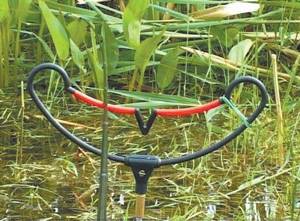
It is near the reed thickets, as well as in shallow water, that you need to look for fish in spring and autumn, and in summer, during intense heat, it goes to the pits. In such conditions, you should carefully examine the bottom and there are situations when fishing for crucian carp with a small and light pickerel turns out to be more effective.
In rivers, the “smaller brother” of carp also feels at ease, but prefers quiet corners and parking areas where you can hide from the ubiquitous pike or perch.
Another advantage of crucian carp fishing is that it uses a variety of gear, both sporting and amateur.
And even those who take their first steps are able to achieve excellent results.
Beautiful and strong crucian carp is caught:
- float tackle;
- feeder;
- homemade bottom fishing rods;
- “tricks” of various types;
- spinning rod
This fish is caught using spinning rods mainly in autumn and winter, but other gear is used throughout the season and is considered quite catchy.
Feeder fishing for crucian carp is a very exciting type of bottom fishing, and along with bream and carp, this fish is the treasured trophy of every fisherman.
Features of catching crucian carp in still water and in the presence of a current
Fishing in currents and in still water is slightly different. On the river it is necessary to use only sliding installations of equipment, either a sliding weight or a sliding leader (one of the two). The length of the leash should be increased. This will prevent the leash and line from twisting in the current.
During currents, heavier feeders are used, as they must hold the equipment at the desired point. It is advisable to use feeders with mesh to retain complementary foods. Complementary food is used with a large number of binding ingredients so that it does not wash out, and the aroma of the bait lingers in the right place.
If you have to fish in the current, you will have to feed more. You should throw the feeder just above the chosen place; the feeder should go down in the current until it reaches the bottom. The rod must be positioned at an angle to the water.
Fishing technique
The bottom fishing technique itself is simple:
- bait the hooks;
- fill the feeder with bait;
- throw;
- put the rod on the stand and monitor the alarm;
- When bitten, we hook and pull.
But the features of these stages are the key to successful fishing.
Feeder bait
When fishing for crucian carp on a feeder, the bait used is the same as on a fishing rod. The only subtlety is that the density of the bait allows it to remain in the feeder until it gets into the water, and then be easily washed out. Therefore, for fishing in still water, more crumbly baits are used, and in the current they are more viscous.
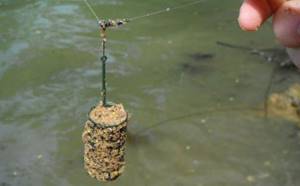
Both purchased and homemade baits are used as bait.
Purchased baits are of the following types:
- Plasticine is a bait similar in consistency to it. It comes in a variety of flavors, such as garlic, anise, hemp, caramel and a number of others.
- Regular groundbaits - to prepare them, simply moisten them and, perhaps, add filler for more, from some kind of porridge. They are very different in composition and smell.
- Granular baits are made from fish meal, similar to those used for industrial fish feeding. They have a longer lasting effect, forming an odorous cloud in the right place. However, they are very free-flowing, so they can only be used in closed feeders or mixed with regular bait.
For homemade baits, porridges from various legumes and grains are steamed or boiled, such as:
- peas;
- millet;
- semolina;
- crushed barley or wheat;
- cracked corn;
- oatmeal, pearl barley, etc.
Add for flavor:
- garlic;
- cake, oil or sunflower seeds;
- hemp seeds or oil;
- anise oil;
- Corvalol;
- other industrial flavors.
Video: bait on a feeder for catching crucian carp
Bait selection
With bait the situation is absolutely similar. All bait is suitable for crucian carp, the main thing is that it does not fly off the hook when it hits the water, and at least stays on it for a bit when biting, otherwise you simply won’t notice it:
- steamed pearl barley;
- maggot;
- earthworm (dung, earthworm, crawling, etc.);
- dough made from semolina or other flour with various flavors;
- special boilies for crucian carp;
- steamed peas;
- steamed or boiled wheat;
- corn;
- bloodworm.
- other plant baits characteristic of the area.
Fishing in still water
To begin with, bodies of standing water should be roughly divided into large (lake, large ponds or systems of interconnected ponds) and small (ponds or small lakes). The main difference between it is that a small body of water, as a rule, is a depression in the ground filled with water with a clear topography, and, accordingly, simply predictable behavior of the fish. The relief of large bodies of water is unpredictable, so for successful fishing you need to study and know it.
In small bodies of water, you should resort to a feeder only during periods of heat, when all the fish go to the depths, to its center. Here we select areas of the shore that are freest from reeds and algae, so as not to interfere with the pulling of the feeder, and throw them closer to the center, in one place. At first, recasts need to be done regularly to feed the place. The fact is that throughout the day, crucian carp, in search of food, migrates virtually across the entire area of such a reservoir, and sooner or later it will stumble upon the area you have fed. Then the bite will begin, the main thing is to wait.
Important: It must be remembered that when a thermocline forms, the fish rarely drops below its border, but stays a little higher. Therefore, in extreme heat there is almost no bite in the pits.
On lakes and other large bodies of water, the bottom topography is different everywhere and the crucian carp will already stick to certain places. During the day and in the heat - holes, lower edges and slopes, in places on the border of the thermocline. In the morning and evening along the reeds (they usually grow along the upper edge of the edge), at the beginning of the shallows. In case of strong water bloom, in areas of underwater springs, places where streams and channels flow between ponds. In such reservoirs, crucian carp can be caught with a bottom from the beginning of summer, when the fish move away from the shore, until almost the end of autumn.
Video: catching crucian carp with a feeder in still water
Fishing on the river
On rivers and other bodies of water with running water (reservoirs, irrigation and other canals), crucian carp prefers quiet places with a slight current, creeks, oxbow lakes, overgrown areas bordering the floodplain, connected by channels with ponds and swamps. You will almost never see crucian carp in the current itself and you won’t be able to feed there. On the river, crucian carp also migrate during the day from one feeding zone to another, moving deeper during the day and approaching the shore at night.
In places with weak currents, it likes to stay in the same places as on lakes. On the lower edges along the reeds, not far from holes, fallen trees and snags, near channels in the reeds. In the absence of reeds, move closer to the thickets of algae and water lilies. By nightfall he goes to the edges of the shallows and goes to the reeds to feed.
It can move closer to the current only during periods of strong water bloom, but during such periods, with an excess of plant food, its bite is very sluggish.
Secrets of a successful catch
When catching crucian carp, and other fish, there are rules and secrets that will help you not to be left without a catch :
- when searching for crucian carp in a pond, you often need to go from the opposite direction. In overgrown areas, they look for free areas; in clean areas, islands of algae. In large reeds they fish in clear water, and vice versa in a large area they look for areas of reeds. On the river there are quiet backwaters and creeks, in ponds and lakes there are channels and currents;
- When starting fishing for crucian carp, always feed the place by making a dozen frequent or just regular casts;
- For catching crucian carp, especially on rivers and large bodies of water, it is better to choose places frequently visited by other fishermen. This tactic will ensure that the place is fed and there are fish there;
- casting too far is not a guarantee of a bite. You need to throw the feeder where there is an edge, hole, ramp, etc.;
- crucian carp can be picky, so if there is no bite, change the bait until you achieve your goal.
